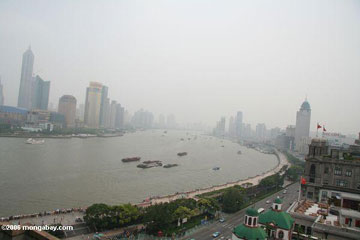760,000 Chinese a year die from pollution
760,000 Chinese a year die from pollution
Rhett Butler, mongabay.com
July 4, 2007
760,000 Chinese die prematurely each year from polluted air and water, according to estimates to be released by the World Bank.
Reuters reports that diarrhea and cancer from dirty drinking water cause 66,000 premature deaths a year, while outdoor air pollution kills 396,000 people per year. Indoor air pollution, mostly from coal-burning stoves and cooking oil, kills another 300,000. The Bank did not calculate death totals directly due to protests from the Chinese government which said that the figures could trigger social unrest. Instead the bank listed the economic costs of deaths from pollution, assuming each life is valued at 1 million yuan ($131,000).
Pollution is one of China’s most pressing environmental issues. A 2005 government study showed that about 300 million Chinese drink unsafe water tainted by chemicals and other contaminants and that 90% of China’s cities have polluted ground water. Meanwhile, a 2005 study by the World Health Organization (WHO), reported that seven of the world’s ten most polluted cities are in China and almost two thirds of the country’s largest cities fail to meet the organization’s air quality standards. The World Bank estimates that pollution is costing the country 8-12% of its GDP in direct losses.
 The Yangtze when it reaches Shanghai |
While these issues could threaten to destabilize the country and derail economic growth, China is at least taking steps to address some of these challenges. In September 2006, the government proposed a plan to curb sulphur dioxide emissions through a trading scheme that would require power plants to pay for the right to emit the pollutant. China is the world’s largest sulphur dioxide polluter, emissions of which have climbed by some 27 percent to 25.5 million tons since 2001. Sulphur dioxide emissions are blamed for worsening acid rain which affects one-third of the country according to Sheng Huaren, deputy chairman of the Standing Committee of parliament.
China also announced it would spend $175 billion protecting its environment over the next five years. The money will be used to reduce pollution, improve water quality, and cut soil erosion. The government has banned logging, spent $190 million on environmental protection along the new Golmud and Lhasa railway, initiated a reforestation project that would plant an area of forest the size of California, and invested billions in renewable energy technologies including wind, solar, and biofuels, setting a target of 12 percent of its power generation capacity coming from renewables by 2020 — up from a 3 percent in 2003. The government’s interest in reducing China’s use of petroleum products extends beyond environmental and health concerns; it sees both the strategic value of mitigating its reliance on foreign oil (currently about 10 percent of oil use) and the economic advantages of being on the technological leading edge of energy production.
Local governments are also seeking to reduce pollution. Last month Shanxi Province, which had 13 of the 30 most polluted cities in China in 2006, said it will pay city government officials 2 million yuan ($262,000) each if they are able to pull their cities out of the ranking of China’s five most polluted cities, according to state media. Cities that see their air quality improve 10 spots in the national ranking system, world reward city heads 2 million yuan ($262,000).
Nevertheless, earlier this year China’s environmental protection agency said the country failed to meet any of its 2006 pollution control goals and blamed the shortfall on economic growth. Further, last month an NGO that advises the Dutch government said that China surpassed the United States as the world’s largest producer of greenhouse gases. However, unlike the U.S., China has announced plans to reign its burgeoning emissions of greenhouse gases.